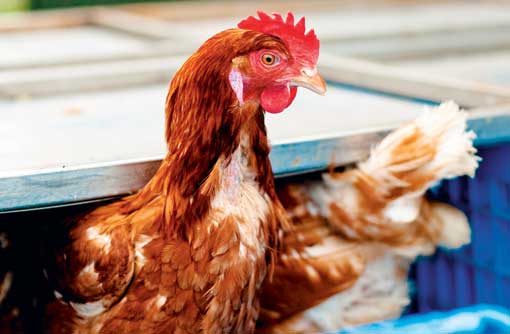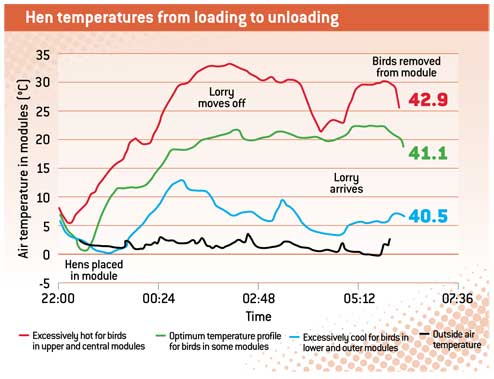Handling and transport at end of lay needs extra care

Within the EU it is illegal to transport any animals, including hens, that are unfit to travel.
However, there is a grey area that permits the transport of slightly unfit animals, provided the transport does not cause additional suffering.
So, how do you identify “slightly unfit” hens at the end of lay and what can you do to ensure that they don’t suffer during transport?
Researchers at the University of Bristol have recently completed a study, funded by DEFRA, to find answers to these questions.
Based on a survey of information from five of the main slaughter plants for a whole year, plus another detailed study of 24 flocks from farm to slaughter, the following have been identified as significant risk factors reducing fitness to travel:
Poor flock health – Disease outbreaks and high levels of mortality, especially towards the end of lay, mean the flock as a whole should be regarded as “slightly unfit” and be handled and transported with extra care. Group-housed hens have higher average levels of mortality than flocks kept in enriched cages and so potentially are less fit. A further indicator of underlying disease is low end of lay production, which increases the proportion of rejects at the plant.
Low bodyweight – Individual hens that are lightweight, or flocks with a spread of bodyweights, are both indicators of reduced fitness. Underweight hens may need to be culled on farm, especially if they appear to be unwell.
Poor feather cover – Birds with poor feather insulation are more likely to be fatally chilled, especially during transport in cold, wet weather, and so should be kept dry and up-stocked. In addition, feather pecking within the flock will increase stress and reduce bird resilience to handling and transport stressors.
Although overall losses during transport are comparatively low (typically 0.15%), the Bristol team was able to determine several of the factors that increase the likelihood of hens not surviving, or having reduced welfare.

The most significant of these were the distance travelled and the external air temperature, with longer journeys and low temperatures increasing the risk. With care, birds can be transported over long distances and in cold weather with zero mortality.
The poultry industry as a whole is keen to have best practices implemented and the British Egg Industry Council will shortly be bringing out a revised edition of its “Joint industry welfare guide to the handling of end-of-lay hens and breeders”.
There is widespread agreement among stakeholders that the points outlined opposite are feasible and would improve the welfare of all birds being caught and transported to slaughter, as well as allowing slightly unfit birds to be transported without additional suffering.
Key points to improve hen welfare at end of lay transportation
1. Planning and communication
There should be communication between the producer, the catching team and the slaughter plant so that each knows what sort of flock to expect and whether extra care is needed. The health, weight and feather cover status of the flocks are key indicators that should be measured and communicated. Planning should include guidelines for drivers regarding where to park under different weather conditions and how to deal with things such as hold-ups on the road or line breakdowns. Stocking rates should be planned according to bird condition and predicted weather, with driver authority to vary these on farm if actual conditions differ.
2. Culling unfit birds on farm Producers/stockmen should go through the flock, culling runts, sick, lame or injured birds before the catchers arrive. Any birds injured during catching must be culled. Birds with leg or wing fractures are unfit to travel.
3. Accepting responsibility All parties have responsibility for hen welfare. On farm, the owner or their representative should oversee the catching and loading. Catchers also have a responsibility to minimise injuries by handling with care. On the road the driver is responsible, but they also need to ensure that unfit birds are not loaded and that appropriate stocking rates are used. At the plant, both management and the overseeing veterinary surgeon are responsible.
4. Lairage
Less fit flocks should be processed without delay and others need space for inspection and ventilation around stacks of modules. There should be frequent inspection of upper/central drawers for panting, indicating heat stress, and lower/outer drawers for wet, huddled or lethargic birds suffering cold stress. All birds should be protected from extremes of weather during lairage. In general, birds within modules are more comfortable when travelling than when stationary.
